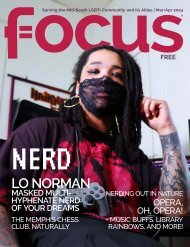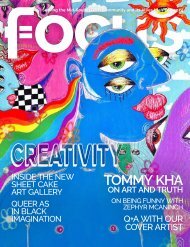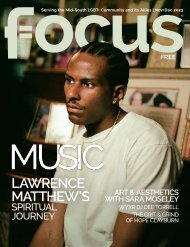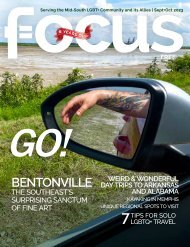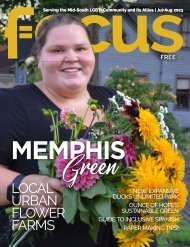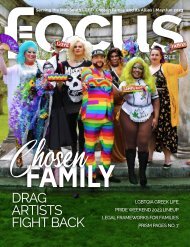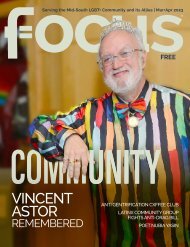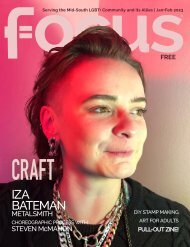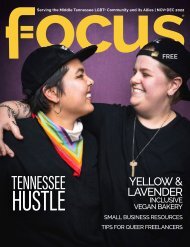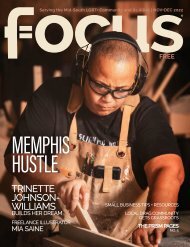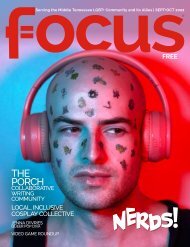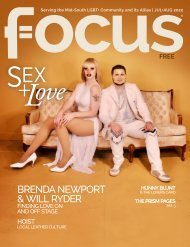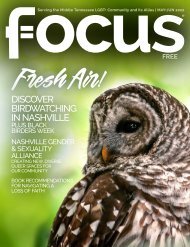2022 Issue 5 Sept/Oct Focus - Mid-South magazine
Nerds!
Nerds!
Create successful ePaper yourself
Turn your PDF publications into a flip-book with our unique Google optimized e-Paper software.
By creating a replication of nonnormative genders<br />
through visual media, a set of rules are created on<br />
how a member of society should exist; however, queerness<br />
is an abstract and fluid identity that transcends the conventions<br />
of linguistic barriers. There is no room for permanence in<br />
queerness, and by crafting stereotypes of our community,<br />
cis-centric society writes a rulebook for a game that<br />
is designed to have no rules.<br />
adapted to the prescribed<br />
identities that are deemed<br />
acceptable to dominant<br />
society. In doing so, we<br />
cast shadows on the parts<br />
of the community that do<br />
not comfortably sit within<br />
the prescribed framework<br />
of gender and sexual<br />
identities. “The shunning<br />
of ‘unintelligible’ gender<br />
embodiments and queer<br />
desire by mainstream<br />
media and culture creates<br />
the shame and shudder<br />
of… rejection.” 5 In other<br />
words, bodies that are<br />
“unintelligible” or exist<br />
outside of our linguistic<br />
capabilities are cast out<br />
for not conforming to the<br />
stereotypes. So, how do we<br />
change the conversation of<br />
queer representation in a<br />
way that expands the cisnormative<br />
understanding<br />
of queerness to<br />
encapsulate rejected<br />
positions? Through<br />
monsters, of course.<br />
In order to imagine<br />
“distinctly queer and<br />
alternative futures,” we<br />
need a device that twists<br />
identity. 6 Removing<br />
preconceived associations<br />
of queer expression by<br />
distorting the human form<br />
creates further possibilities<br />
to express abstract<br />
and expansive ideas. In<br />
providing an alternative<br />
visual representation to<br />
communicate queerness,<br />
the idea is much more<br />
approachable to the nonqueer<br />
eye. It retracts the<br />
linguistic conventions that<br />
allow political hierarchies.<br />
We are no longer bull<br />
dykes, trannies, queers,<br />
hermaphrodites, tomboys,<br />
sissies, gays, lesbians, and<br />
fags. We are monsters:<br />
unknown and intriguing.<br />
We are something<br />
otherworldly and strange,<br />
worth investigating,<br />
cautiously, for beasts lie in<br />
the shadows. Transgender<br />
theorist Susan Stryker<br />
beautifully outlines the<br />
power of monstrosity:<br />
“Monsters, like angels,<br />
function as messengers<br />
and heralds of the<br />
extraordinary. They serve<br />
to announce impending<br />
revelation, saying, in effect,<br />
‘Pay attention: something<br />
of profound importance is<br />
happening.” 7<br />
By transforming queer<br />
identity from the human<br />
to the non-human, people<br />
are able to set aside<br />
notions of prescribed fear<br />
for a different element<br />
of fear–fear of the<br />
unknown. The unknown<br />
is unexplainable, and so<br />
is queerness. “To detour<br />
around the obstruction<br />
of unbearable reality,” is<br />
to forge a new path of<br />
representation, one that<br />
relies on the ambiguous<br />
tactics ingrained in queer<br />
theory. 8 Through altering<br />
our reality, we provide<br />
spaces for new one–ones<br />
that are fantastic, fabulous,<br />
crude and unapologetic.<br />
There becomes room<br />
for the queers, freaks,<br />
monsters, dragons,<br />
ghouls, fairies, furries,<br />
cenobites, werewolves,<br />
demons, vampires, the<br />
undead, witches, warlocks,<br />
angels, aliens, sentient<br />
orbs, celestial beings, and<br />
creatures of the night.<br />
REFERENCES:<br />
1. Jones, Stacy Holman, and Anne<br />
Harris. (2016).<br />
2. Jones, Stacy Holman, and Anne<br />
Harris. (2016).<br />
3. Butler, J. (2014).<br />
4. Butler, J. 1993. Bodies That Matter: On<br />
the Discursive Limits of ‘Sex’. New York:<br />
Routledge.<br />
5. Jones, Stacy Holman, and Anne<br />
Harris. “Monsters, Desire and the<br />
Creative Queer Body.” Continuum 30,<br />
no. 5 (2016): 518–30. https://doi.org/10.<br />
1080/10304312.2016.1210748.<br />
6. Halberstam, J. 2011. The Queer Art of<br />
Failure. Durham, NC: Duke University<br />
Press.<br />
7. Stryker, S. 2006. “My Words to Victor<br />
Frankenstein above the Village of<br />
Chamounix: Performing Transgender<br />
Rage.” In The Transgender Studies<br />
Reader, edited by S. Stryker and S.<br />
Whittle, 244–251. New York: Routledge.<br />
8. Solnit, R. 2014. The Faraway Nearby.<br />
New York: Penguin.<br />
focuslgbt.com | Nerds! 13




